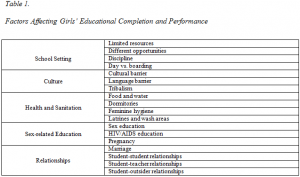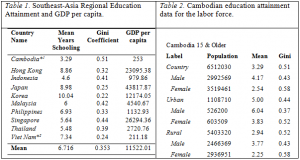Angelica Hagman and Dr. Donald Holsinger, Educational Leadership and Foundations
The main objective of this research project, spearheaded by Dr. Donald Holsinger, was to calculate the Gini Index of Education for Cambodia. Simply put, the Gini Index is a measurement of equality; the higher the quantitative score, the greater the inequality and vice versa. The Gini Index, or coefficient, of education is a measure of equality in educational attainment, or in other words a measure of the distribution of education. High educational inequality is undesirable in many aspects; among other things, high educational inequality in a country hinders its economic development.
In measuring the distribution of education attainment, we chose to calculate the Gini Index of education (E-Gini) at the national, provincial, and district levels, as opposed to only a national indicator. The county level of analysis is better suited for comparative purposes; analyzing the distribution of education attainment of smaller political units allows national and regional governments and ministries of education to target policies and programs to specific regions and groups of people. This targeted approach simplifies and increases the effectiveness and efficiency of educational reforms and policy. The provincial and district levels of analysis provide policymakers with more representative information regarding the actual distribution of education in each region and the groups that are currently being underserved by the education system. I personally got very excited about this part. Funds do not just have to be spent haphazardly without knowing where the greatest needs in the country exist, but the targeting can be more precise and thus potentially decrease the educational inequality. The research we conducted specifically looks at the Cambodian labor force and examines the distribution of education among urban/rural and male/female populations in the 24 provinces and municipalities and all 180 districts.
We processed large amounts of census data, primarily in MS Excel, to arrive at the E-Gini itself. We also interviewed and collected information from various educational experts and ministries in the country to better understand the country and educational situation as well as the E- Gini results. Cambodia is a poor developing country, and we knew from the outset that the average number of years of schooling was very low. We also expected the E-Gini to show us fairly high inequality. We were not mistaken in this. The amount of educational attainment inequality as evidenced in the E-Gini (on a country-level analysis) was greater than any other country in South-East Asia for which the E-Gini has been calculated (see Table 1). We also found that the educational inequality was greater in rural areas as compared to urban areas. The inequality was also greater for females than for males in both rural and urban areas (see Table 2). These results were not entirely unexpected, but the extent of the inequality in some provinces and districts of Cambodia is shocking. Our findings actually show that the educational inequality for urban females was greater than for the rural males, thus showing a strong gender discrepancy in the country. Another important aspect we discovered in terms of years of schooling is that in some provinces, many people did not even have one year, and few had more than a couple of years, of schooling.

Although we succeeded in calculating the E-Gini for the 24 provinces and 180 districts in Cambodia, there is still a lot more research to be conducted. The quantitative E-Gini numbers are substantial in providing important information as to where the problems lie geographically, but more research needs to be conducted in relation to the underlying reasons for the educational inequality we noted in the E-Gini results. Knowing the specific qualitative factors which explain the high educational inequality will aid greatly in policy making, thus potentially lessening the educational inequality in the country and ultimately alleviating poverty for a large group of people. We have started to research the additional qualitative and quantitative facts by, among other things, gathering additional data from Cambodian ministries and educational experts.
The research process itself was tedious at times; calculating the E-Gini itself for all the provinces and districts of Cambodia meant a lot of work at the computer. The internal reward when we finished the computing was great though; we had diagnosed something in quantitative terms that we only had a hunch about. I was personally very excited about the importance of the information and the potential effects on educational policy-making. At the same time, I realized how much more needed to be done in terms of additional research and in applying the findings. We knew where the problems were in terms of geography, but the reasons for the results were more complicated. The information we gleaned from educational and other experts helped us, and will help us and others in the future, to come closer to understanding the numbers we calculated. The qualitative work may prove an even more important step in the research.
This opportunity, both in terms of conducting the research and my adventure in Cambodia, was one of the best experiences of my life thus far. I am grateful that I had the chance to be a part of something that has the potential to actually help governments and other organizations help the people of the world. This opportunity helped me prepare for further educational and career pursuits. I am also grateful for the experiences I had in Cambodia that helped me gain wisdom and compassion.

